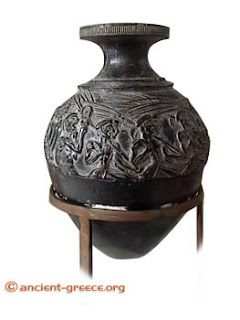Excerpt from "The llustrated Legends of the Kitano Shrine"
This is part of a larger series of paintings which tell the story of the origin of the Tenjin cult, a central part of Shintoism. Tis type of narrative painting is called Emaki.
Sculpture of Zao Gongen
This is a Shinto deity whose image was inspired by the Buddhist Gods of Brightness. His cult was Shugendo, which was devoted to mountain worship.
Sculpture of Fudo Myoo
Fudo Myoo is the most prominent of the aformentioned Kings of Brightness, and was considered the defender of Buddhism, whose sword cut through ignorance. These two statues exemplify the intense religious competition that took place in Heian Japan.
Lotus Sutra
The Lotus Sutra gained popularity because it emphasized that the Buddha's compassion was open to all, which was enticing to women and the lower classes in Japan. The Lotus Sutra is stuctured in a way that is not at all dissimilar to an Emaki, using sequential illustrations as a method of storytelling.
Heart Sutra
The Heart Sutra's main tenet was that true wisdom comes from emptiness, the haloed figures surrounding the Buddha in both Sutras are Bodhisatvas. Interestingly, the technique is very similar to Song Woodblock techniques.
Wooden Figure of Fudo Myoo
Another King of Light, Fudo is the enemy of illusion, showing the true enlightenment beyond life and death. Fudo's sword is used to cut away illusions and expose reality.
A Battle between the Minamoto and Taira Clan
This massive screen serves to commemorate a critical battle between to warring clans, however it blends the events of two. The first two panels represent the battle of Yashima, and the last two panels represent the battle of Dannoura, which resulted in the final defeat of the Taira.
Battles of Ichinotani and Yashima
Here you can recognize the battle of Yashima from the first screen, but this portrayal was far after the fact, in the Edo period. The reason that this battle retained salience is that it was this conflict that resulted in Minamoto no Yoritomo become Japan's first Shogun.
Wooden statue of Kichijoten
Kichijoten's place in Heian culture is surprising, and this statue only makes it more so. Kichijoten is derived from Laksmi, wife of Vishnu and member of the Hindu Pantheon. Even more bizarrely, she is depicted here in Tang dynasty clothes. Her existence as a Japanese deity is strange given her outdated Chinese attire and hindu origin. Her gestures represent the overcoming of calamities and the granting of desires.
Ceremonial Jar
This ceremonial jar comes from Sanage, which gained prestige for there use of leftover ash as makeshift glazing. This was the closest Japan could come to the Chinese full glazing techniques. Ironically, it may have been a funerary jar.
Tale of Ganji
Handscroll paintings based on the famous novel of the same name, this is part of a larger collaborative work called Ganji-e, which told the story of Ganji in great detail through a series of different art pieces in different styles.






































blah%5B6%5D.jpg)















